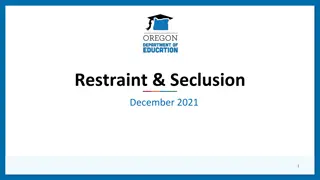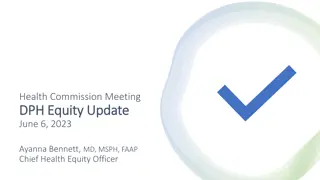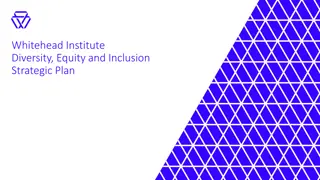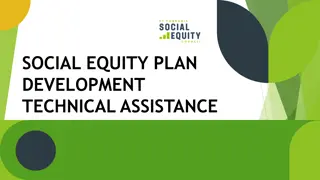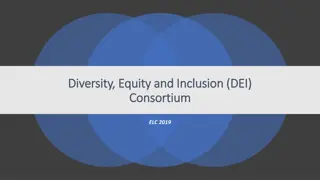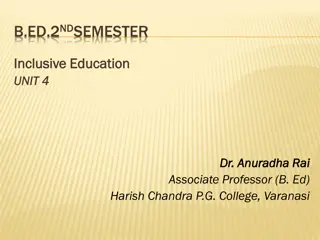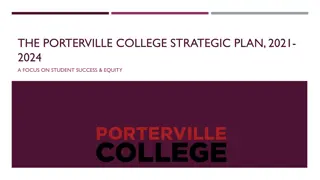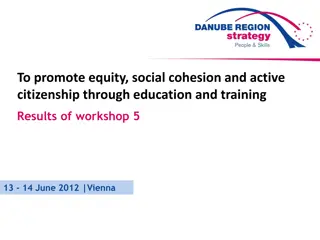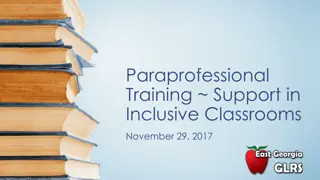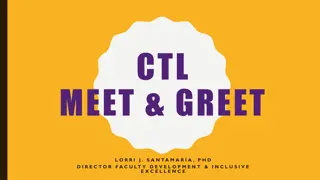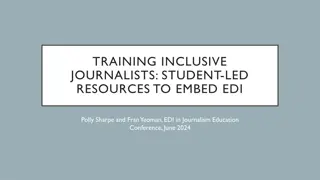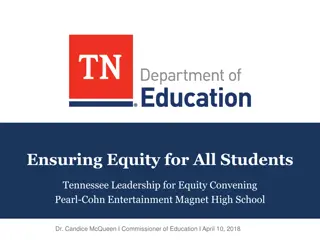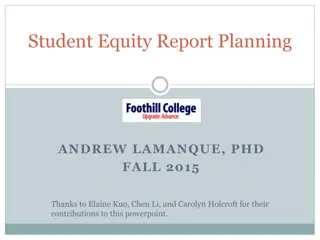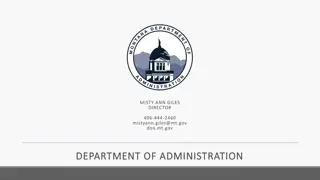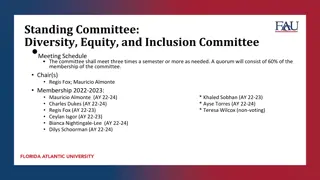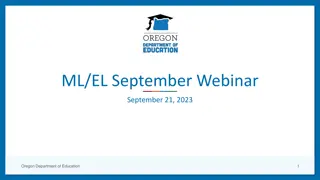Student Equity Report: Goals and Initiatives for Inclusive Education
Berkeley City College's Student Equity Report outlines goals to increase access, course completion rates, and basic skill success for diverse student populations. Initiatives include outreach, retention strategies, and supplementary support, focusing on ethnic minorities, students with disabilities, and underrepresented groups. Data comparisons from 2007 to 2010 show progress in enrollment, course success, and skill completion rates.
Download Presentation

Please find below an Image/Link to download the presentation.
The content on the website is provided AS IS for your information and personal use only. It may not be sold, licensed, or shared on other websites without obtaining consent from the author. Download presentation by click this link. If you encounter any issues during the download, it is possible that the publisher has removed the file from their server.
E N D
Presentation Transcript
Student Equity Report Prepared by Berkeley City College, Faculty, Administrators, and Staff May, 2012 Data Sources: PCCD Institutional Research, CCCCO Data Mart, CPEC, Census 2010 1
Goal 1 Student Access GOAL Increase enrollment of diverse ethnic students and disabled students from local high schools, community-based organizations, and other community-based groups. Comparative data Between 2007 and 2010, BCC annual enrollment headcount increased by 25.7% from 9,808 to 12,326. DSPS enrollment decreased from 417 (4.3%) to 409 (3.3%). 2
Goal 1 Student Access Plan Implement major outreach and retention initiatives to increase enrollments of Hispanics, students with disabilities, and other under-represented student populations. Comparative data: PCCD Service Area 2010 Census BCC FY2010-11 African-American: Hispanic: Native American: Asian/PI: White: 20% 12% 0.5% 19% 25% African-American: Hispanics: Native American Asian: White: 20% 20% 0.3% 20% 35% 3
Goal 2 Course Completion - Goal Increase the course completion rate of diverse student populations by initiating specific interventions that promote the completion measured by course success rate. Between 2007 and 2010, course success rates increased among all ethnic groups and for both male and female student groups DSPS success rates increased slightly from 61% to 63% However, gaps exist among the groups; the biggest gap for 2010 rates existed between white s 76% and African- American s 52%. 4
Goal 2 Course Completion/Success Plan Offer intensive supplementary teaching and learning support to African-American, Native American, male, and students with disabilities. Course Success Rate, Fall 2007 Fall 2010 Female: 66% - 69% Male: 60% - 65% BCC: Asian: White: Hispanic: African-American:50% - 52% Native American: 49% - 62% 64% - 67% 70% - 73% 70% - 76% 62% - 68% DSPS: 61% - 63% 5
Goal 3 Basic Skill Success - Goal Increase the number and rate of basic skill course completion/success for students from diverse population groups Successful Grades Success Rates - F 2007 F2010 110 - 49% - 62% English: 174 ESL: Successful Grades - Success Rates - 40 78% - - 23 82% Math: Successful Grades - Success Rates - 87 39% - - 197 55% 6
Goal 3 Basic Skills Course Success Rates, Fall 2010 Comparative data White Hispanic Asian/PI/F African- American Native American Math English ESL 100% 70% 80% 68% 74% 75% 59% 62% 48% 45% 59% n/a n/a 100% n/a TOTAL 55% 62% 82% 7
Goal 3 Basic Skills Course Completion and Success - Plan Offer intensive supplementary teaching and learning support to basic skills English students, regardless of ethnicity Offer intensive supplementary teaching and learning support to African-American students enrolled in basic skills math classes Acquire completion and success rates for other under- represented student groups, e.g., DSPS 8
Goal 4 Degree and Certificate - Goal Increase the number of students by population group who receive a degree or certificate Berkeley City College awarded 146 students in both 2007-2008 and 2010-11 with an association degree and/or a certificate. Total number of associate degree awards increased from 93 to 113. The number of certificate awards decreased from 53 to 33. 9
Goal 4 Degree and Certificate by Ethnicity, 2009-10 Associate Degree 96 Certificate - 24 African-American: White: Asian/Pl: 11 or 11% Hispanic: 14 or 15% Native American: 2 or 2% African-American: 27 or 28% 24 or 25% 4 or 17% 11 or 46% White: Hispanic: 2 or 8% Asian: 4 or 17% 10
Goal 4 Degree and Certificate Plan Encourage and facilitate all students, especially those who plan to transfer without a community college degree, to receive a degree/certificates from PCCD Encourage or facilitate Asian/Pacific Islanders and Filipinos to receive an associate degree prior to transfer Acquire transfer information for other under-represented student population groups 11
Goal 5 Transfer - Goal Increase the number and ratio of transfers, especially African American, Latino, and disabled students to transfer after one or more (up to six) years. Comparative Data Total number of transfer increased from 170 in 2007 to 196 in 2010 CSU transfer decreased from 90 to 75 UC transfer increased from 80 to 121 The 6-year transfer rate for 2005-06 cohort is 42% for both BCC students in general and DSPS students. 12
Goal 5 Transfer, 2010 Transfer by Ethnicity 2010 UC 2010 CSU BCC Total: 121 BCC Total: 75 White: Hispanics: Asian/Filipino: African-American: 42% 14% 22% White: Hispanic: Asian/Filipino: African-American: 27% 11% 14% 10% 21% 13
Goal 5 Transfer - Plan Acquire information on number of transfers from BCC to in- and out-of state, public and independent institutions of higher education annually Offer intensive transfer counseling and information, and assist in transfer preparation for: All BCC students with a degree/transfer goal African-American students transferring to UC Asian/Filipino students transferring to CSU 14
Innovative and Proactive Student Equity Programs and Strategies Mandatory new student orientation First Year Experience Basic Skills Initiative, Title 3, TRiO Program review and Student Learning Outcome (SLOs) Faculty support and development initiatives Faculty engagement in state-wide learning groups Cohort learning Team teaching Interdisciplinary programs, e.g., PACE, Global Studies, Persist Outreach/In-reach and Student Ambassador Program. Triage/eCounseling. The number of student served by counseling increased significantly over a three-year period, from 2,234 to 7,992 Articulation and Transfer Active Student Activities and Clubs 15




